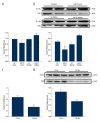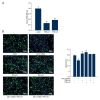MicroRNA-21 Contributes to Liver Regeneration by Targeting PTEN
- PMID: 26744142
- PMCID: PMC4716711
- DOI: 10.12659/MSM.896157
MicroRNA-21 Contributes to Liver Regeneration by Targeting PTEN
Abstract
Background: Multiple microRNAs (miRNAs, miRs), including miR-21, have been documented to be critical regulators of liver regeneration, but the mechanism underlying their roles in hepatocyte proliferation and cell cycle progression is still far from understood.
Material/methods: miR-21 levels were determined using qRT-PCRs in mouse livers at 48 h after 70% partial hepatectomy (PH-48 h). Cell proliferation was determined by use of a cell-counting kit-8 (CCK-8), EdU incorporation staining, and flow cytometry. Phosphatase and tensin homolog (PTEN) expressions were determined using qRT-PCR and Western blot analysis. PTEN siRNA was used to perform the rescue experiment.
Results: A marked upregulation of miR-21 was observed in mouse livers at 48 h after 70% partial hepatectomy (PH-48 h) compared to 0 h after PH (PH-0 h). Overexpression of miR-21 was associated with increased proliferation and a rapid G1-to-S phase transition of the cell cycle in BNL CL.2 normal liver cells in vitro. In addition, we showed that PTEN expression was inversely correlated with miR-21 in BNL CL.2 cells and demonstrated that PTEN expression is lower in mouse livers at PH-48 h. Moreover, the presence of PTEN siRNA significantly abolished the suppressive effect of miR-21 inhibitor on hepatocyte proliferation.
Conclusions: miR-21 overexpression contributes to liver regeneration and hepatocyte proliferation by targeting PTEN. Upregulation of miR-21 might be a useful therapeutic strategy to promote liver regeneration.
Figures






Similar articles
-
miR-382 targeting PTEN-Akt axis promotes liver regeneration.Oncotarget. 2016 Jan 12;7(2):1584-97. doi: 10.18632/oncotarget.6444. Oncotarget. 2016. PMID: 26636539 Free PMC article.
-
MicroRNA-21 accelerates hepatocyte proliferation in vitro via PI3K/Akt signaling by targeting PTEN.Biochem Biophys Res Commun. 2014 Jan 17;443(3):802-7. doi: 10.1016/j.bbrc.2013.12.047. Epub 2013 Dec 14. Biochem Biophys Res Commun. 2014. PMID: 24342610
-
MiR-17~92 ablation impairs liver regeneration in an estrogen-dependent manner.J Cell Mol Med. 2016 May;20(5):939-48. doi: 10.1111/jcmm.12782. Epub 2016 Jan 19. J Cell Mol Med. 2016. PMID: 26781774 Free PMC article.
-
MicroRNAs in Liver Regeneration.Cell Physiol Biochem. 2015;37(2):615-28. doi: 10.1159/000430381. Cell Physiol Biochem. 2015. PMID: 26344368 Review.
-
The role of microRNAs in the different phases of liver regeneration.Expert Rev Gastroenterol Hepatol. 2023 Jul-Dec;17(10):959-973. doi: 10.1080/17474124.2023.2267422. Epub 2023 Oct 24. Expert Rev Gastroenterol Hepatol. 2023. PMID: 37811642 Review.
Cited by
-
Molecular and Functional Roles of MicroRNAs in the Progression of Hepatocellular Carcinoma-A Review.Int J Mol Sci. 2020 Nov 7;21(21):8362. doi: 10.3390/ijms21218362. Int J Mol Sci. 2020. PMID: 33171811 Free PMC article. Review.
-
High expression of miR-21 is not a predictor of poor prognosis in all patients with hepatocellular carcinoma.Mol Clin Oncol. 2018 Jun;8(6):733-739. doi: 10.3892/mco.2018.1603. Epub 2018 Apr 3. Mol Clin Oncol. 2018. PMID: 29732156 Free PMC article.
-
Cell Sources and Influencing Factors of Liver Regeneration: A Review.Med Sci Monit. 2020 Dec 14;26:e929129. doi: 10.12659/MSM.929129. Med Sci Monit. 2020. PMID: 33311428 Free PMC article. Review.
-
Regulation of ERK and AKT pathways by hepatitis B virus X protein via the Notch1 pathway in hepatocellular carcinoma.Int J Oncol. 2017 Nov;51(5):1449-1459. doi: 10.3892/ijo.2017.4126. Epub 2017 Sep 15. Int J Oncol. 2017. PMID: 29048612 Free PMC article.
-
Comprehensive analysis of lncRNA-miRNA-mRNA during proliferative phase of rat liver regeneration.J Cell Physiol. 2019 Aug;234(10):18897-18905. doi: 10.1002/jcp.28529. Epub 2019 Mar 27. J Cell Physiol. 2019. PMID: 30916358 Free PMC article.
References
-
- Fausto N. Liver regeneration. J Hepatol. 2000;32:19–31. - PubMed
-
- Michalopoulos GK. Liver regeneration: molecular mechanisms of growth control. FASEB J. 1990;4:176–87. - PubMed
-
- Michalopoulos GK, DeFrances MC. Liver regeneration. Science. 1997;276:60–66. - PubMed
-
- Taub R. Liver regeneration: From myth to mechanism. Nat Rev Mol Cell Biol. 2004;5:836–47. - PubMed
-
- Li W, Zhu H, Bao W, et al. Involvement of metastasis tumor antigen 1 in hepatic regeneration and proliferation. Cell Physiol Biochem. 2008;22:315–26. - PubMed
Publication types
MeSH terms
Substances
LinkOut - more resources
Full Text Sources
Other Literature Sources
Research Materials

